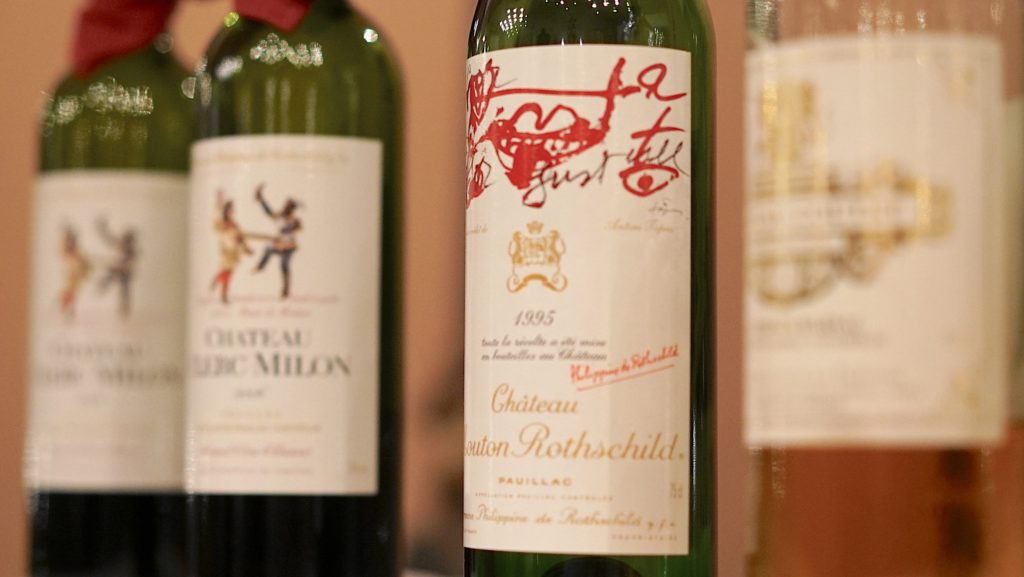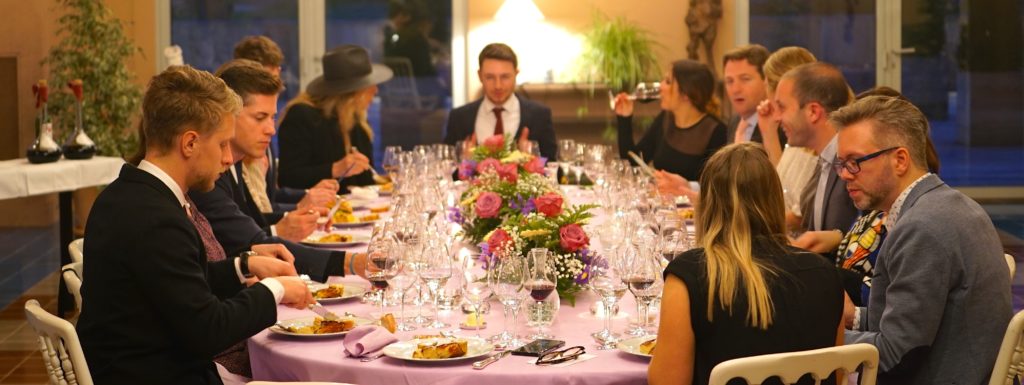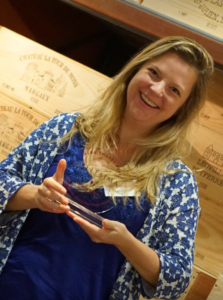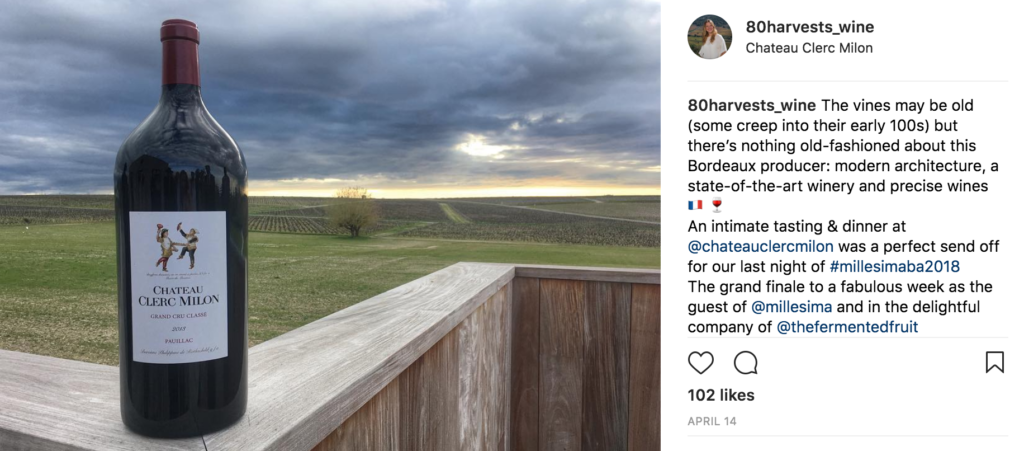Bordeaux’s en primeur week has always struck me as something of a mystery, and perhaps a little old-fashioned. The idea of evaluating wines before they are ready, putting a price on them prematurely and forming an opinion before you’ve even spat the wine into the spittoon – I was definitely a doubter. However, following a week of hopping between merchants, chateaux and en primeur tastings as the guest of the Millésima Wine Blog Awards, I now have a slightly different perspective of what’s behind Bordeaux’s en primeur.
En Premier for anyone who isn’t au fait with the term translates as ‘premieres’, or is known as ‘futures’ in the US. The translation doesn’t really do it justice though, as en primeur is a wine ritual deeply rooted in the past and helps explain how Bordeaux became the most famous wine region in the world.
Bordeaux’s en primeur and trade structure
Why en primeur is a key to Bordeaux’s structure
Bordeaux has been producing wine since the Romans arrived 2000 years ago and the city’s convenient riverside location has enabled Bordeaux to have a constant flow of international trade ever since the Middle Ages. The English, the Dutch and the Germans have all had a penchant for Bordeaux wine over the centuries and its early establishment as an international export is what gave it the unique trade structure that remains intact today.
Bordeaux’s trade structure, referred to as the ‘Place de Bordeaux’, can be split into three tiers: the chateaux, the courtiers and the négociants:
The Châteaux (the growers)
Each château is effectively a wine producer (they might purchase grapes or have their own estate, but the chateau is the one that makes the wine). Wine was historically sold in bulk to the merchants (the négociants) who would blend it and sell it to the market under their own name. It wasn’t until the 1920s that producers starting bottling their own wine at the château, a change impulsed by the young Baron Philippe de Rothschild of Chateau Mouton Rothschild in 1924. In 1967, estate bottling became mandatory for all the First Growths designated in the 1855 Classification. While estate bottling is common for high-end wines, there is still a large proportion – over half in fact – of Bordeaux wine that is sold in bulk and bottled by the négociant.
The Courtiers (brokers)
These are the middlemen, who would negotiate between the châteaux and the négociants. The often organise the wine samples from the chateaux and submit them to the merchants, and then negociate the best price and arrange the final deal.
On average, a broker is paid a 2% commission by the merchant (négociant). A good broker would seek out excellent, up-and-coming producers to help bring them to market, and advise the négociant clients on what’s best to purchase that vintage, whereas a less involved broker just provides the paperwork for the transaction between growers and négociants. However, long-standing relationships are vital for good allocations, and it is perhaps telling that when it comes to selling Grand Cru, over 95% goes through a broker.
The broker’s role also remains very important on the lower end of the scale, when wine is being sold in bulk. These wines are often blended and aged by négociants so the broker acts as their eyes, ears and tongue. Brokers – like négociants – are usually focused on a specific style sector or region.
There are some 90 brokers in Bordeaux today but the broker business is concentrated to just 20% of the brokers who rule the roost with over 80% business share.
The Négociants (merchants)
Négociants are historically the merchants located in the city of Bordeaux, on the riverbank in the area of Chartrons. Merchants tend to specialise in certain sectors of the market, and so their role will change depending on the wine they are trading:
- Generic/bulk wine market: The merchant buys, blends and sells the wines in bulk or in bottle. The merchant determines the style, origin and price of these wines.
- Middle range: The merchant buys wines from individual chateaux to sell onwards either in bottle, or in bulk (but doesn’t blend)
- Exclusive, top wines: Buys the individual chateaux wines en primeur and then releases them at different maturity levels (storing the wine in their own cellars in Bordeaux). For the top cru a merchant often has a limited allocation each year.
The négociant has an important role in not only selling the wines to the marketplace (usually to importers, restaurants and retailers rather than the direct consumer) but also in the marketing of wines. A château or grower might only have a couple of wines or a few hectares and, unless they are one of the top cru, rarely have the budget to spend on marketing and press – that’s the job of the merchant.
.
There are many pros and cons to this system and it is a topic of heated debate in Bordeaux and worldwide. In theory, all the layers within the ‘Place de Bordeaux’ can protect producers and négociants in bad years, and help them benefit in good years. Ultimately, whether it’s a good or bad year, the consumer ends up paying more but the merchant also carefully selects and stores the wine – acting as a curator for quality and ensuring the wine provenance is solid.
I cornered Fabrice Bernard, CEO of Millésima, to find out the role of the merchant in this system. You can see a clip here below, or watch the full interview online (disclaimer: I rather cruelly asked Fabrice for the interview after we had both indulged in a five-course wine dinner at Millésima, so forgive our wine hiccups in the full version).
What is En Primeur? And what are the main tastings like?
The main act of the en primeur week is the ‘silent’ tastings (I use inverted commas because they aren’t silent at all… ‘hushed’ at most) held at different châteaux and exhibition halls across Bordeaux. This is where producers line up behind a table with a mock-up of what their vintage release might look like. ‘Mock-up’, because these are barrel samples and sometimes they happen to be the final blend, but in many – and most – cases it is actually an early blend of the barrels and the final blend may differ when it comes to bottling the next, or following year.
It’s a tasting in which merchants and members of the press taste the new vintage and a first chance to get an overall impression of the vintage (whether it was a fresh year, a riper year, a balanced year etc) and decide whether these are wines to be cellared for a long time or consumed young. It can be taxing tasting barrel samples (tannins can be as tough as boots), but you get a glimpse into the wine and seasoned tasters will be able to compare their mental notes with previous vintages and make a guesstimate on how well this vintage will age and when they should aim to sell it.
The press cast their vote and publish big headline announcements about the quality of the vintage, and the merchants decide the price they are willing to pay and how much they might want to purchase at this stage. The real business though is going on behind closed doors.
Some châteaux already have their steady clients and they will make the same allocation to their buyers as last year, rendering the whole mating ritual a little pointless. But for some other châteaux, this is the moment to batter your eyelids and lock down a sale with a merchant in order to get coins in the coffers before working on the next vintage.
When do merchants buy wine in Bordeaux?
The en primeur is usually in the March or April after the harvest (approximately 6 months after harvest), however some merchants might purchase the wine even before then. There are several different stages when a merchant might buy wine:
- Sur Souche (literally meaning, ‘on the stump’): This is a risky bet. The merchant is purchasing the wine before it has even been made – before the harvest. It is a blind purchase because you don’t know about the quality of the vintage, you are only relying on the reputation of the producer.
- En primeur: The big tasting week in late March/April. There are usually two en primeur offerings.
- Following tranches: After the en primeur period, wine is sold in several tranches until the stock is gone. With each tranche, the price usually increases (to reflect the extra time stored/cared for in the winery, and the wines readiness for the market). The exception would be where poor vintages are superceeded with better vintages and the wine might lose value as time passes.
The Millésima Wine Blog Awards experience of en primeur
I was in Bordeaux last month because Bordeaux wine merchant Millésima had flown me and five other wine bloggers there for a week-long action-packed en-
We were invited to taste along with all the experts and cut our teeth on Bordeaux’s 2017 vintage. It was an interesting experience (the vintage was a mixed bag between the severe frost, dry summer and reduced yields) from hundreds of different estates and all the major Bordeaux regions. But – as you can imagine with the world’s wine capital – it wasn’t just a week of tannins and black teeth.
The en primeur week is also about networking and social events. Even though the vintage was a painful one for many (I spoke to several estate-owners who had lost over 90% of their crop this vintage to frost), the show still goes on. Producers put on a brave face, pouring the little wine they have, and welcoming guests who’ve travelled far and wide to get there (the Chinese were the biggest visiting nationality this year). Wineries host lavish dinners and lunches, and buyers and members of the press imbibe and indulge. Our Millésima experience was no exception.
Located in Bordeaux city, Millésima is a relatively new merchant in the world of Bordeaux – founded in 1983. Without any precedence to follow, Millésima decided to do their business a little differently to the other merchants – not only selling to the trade but also selling direct to consumers since 1987. The other innovation is, of course, that they organise and own the annual Millésima Wine Blog Awards. Another quite ballsy move in a country where the wine press is extremely traditional and ‘social media influencer’ isn’t a popular job title.
This is the 5th year of the awards, and each year they have a different sponsor – and luckily for us, the 2018 edition was Château Clerc Millon owned by the Rothschild family. This family also owns Château Mouton Rothschild, which was famously the first château to estate-bottle their wine in the 1920s, is the only château to have been elevated to First Growth status since the 1855 classification (in 1973), and has raised more than a few eyebrows with their daring and risqué art labels which change for each vintage. The family also owns Opus One in California, and Almaviva in Chile.
Mid-week we had our first lunch at the Rothschild’s wine residence – at Château Mouton Rothschild. Following an en primeur tasting of their latest releases (which were, predictably, sublime) we were greeted by the Rothschild family for a sit-down wine lunch with their winemaker Philippe Dhalluin and all three of the Rothschild children, who today run the business following their departure of their late mother, Baroness Philippine.
Each child – all verifiable adults now – brings something different to the family company: Camille has the organisation and overall management skills, Philippe offers business acumen and a forward-thinking attitude, and Julien offers creative flair and a contagious charisma. It was a privilege to sit down at what felt very much like a family lunch and enjoy stories of wine labels past and discuss the merits, and downfalls, of being on social media.

Our second date with the Rothschild estates was at the nearby Château Clerc Milon and also in Pauillac. This château also has an interesting story to tell as a historic property that has been a Fifth Growth since the 1855 classification but was in disrepair when the Rothschild family purchased it in 1970. Philippe de Rothschild (Snr) bought just over 16 hectares with the property and, over the last forty years, the family has been painstakingly piecing together and purchasing small vineyards to unify their vineyard closer to its original size, today reaching 41 hectares. It’s not been an easy feat in a part of the world where vineyard land is in extremely high demand and sold very rarely.
From the outside, Clerc Milon is a very modern winery – with wood panels, glass and stone constructed into an environmentally-friendly winemaking space reflecting the materials used in wine production. The winemaking also has a modern approach – a blend of five varieties. Each batch of grapes is separately microvinified (by plot, variety and soil), then separately barrel-aged, with the final blend not being prepared until two years later. We had the pleasure of tasting a vertical of their wines through to recent barrel samples (our own en primeur tasting!) of some of their separate varieties – including a Carmenère from among the 14 hectares that are all that is left of this variety in Bordeaux today.
There were several more highlights to the week, including the official press dinner (a veritable buffet of interesting wines and fine food) at Château Kirwan; a Sauternes-paired lunch at Château Guiraud; a breathtaking vertical at Couvent des Jacobins in Saint Emilion; and a bistro dinner at the modern terrace restaurant of Château La Dominique overlooking some of the most famous vineyards of the right bank.
It was as indulgent as it sounds. And so, while Bordeaux’s en primeur week is supposedly about the vintage, it is also – and evidently much more so – about business. And a big part of business in Bordeaux is about pleasure. Lucky us.


This is not your usual 80 Harvests post. I was travelling for 80 Harvests, but this visit wasn’t about a wine region or a wine producer in particular, I was actually travelling as a prize! Earlier in the year, I was thrilled to find out some of my 80 Harvests articles had been shortlisted for all three categories of Millésima Blog Awards (Food and Wine, Wine and Travel, Wine Reporter) and even more chuffed to find out a month later that 80 Harvests had won! Thank you so much to everyone who voted for 80 Harvests and supported us in the competition, and thank you to Millésima for organising the awards and creating such a memorable experience as our prize.
Meet the other Millésima wine blog winners

Kelly Mitchell aka. The Wine Siren
Dressed all in black, Kelly is the equivalent of Johnny Cash – only she is a blond bombshell. Based in Napa, Kelly writes about Californian wine but also travels further afield frequently galavanting to European wine regions.
Ryan Hara aka. The Fermented Fruit
Ryan’s premise is simple – share great wines at prices that you can afford – however his knowledge is far more profound. Ryan is a closet wine geek and super taster, he can blind spot a Domaine Chevalier from a mile away.
With his drone in his pocket, French sommelier-turned-blogger Fabian is a multimedia wine communicator who takes you on a visual journey with him around the vineyards of Europe.
Lori Budd aka. Dracaena Wines
Lori and her husband Mike are the winemaking dream team behind Dracaena Wines in Paso Robles, California. In her spare time, when she isn’t teaching or drinking Cabernet Franc, Lori likes to make winemaking and science digestible for readers on her blog.
Ruben Luyten aka. Sherry Notes
Sherry notes is a blog I found invaluable studying my WSET diploma – Ruben is a sherry buff following several years living in the region and he has compiled one of the best resources on sherry tasting notes and releases. He’s also quite seriously into whisky.
Photos kindly provided by Frederic Lot, a photographer by day but a serious Bordeaux drinker by night. He also created these video highlights from the Millesima wine blog awards:
Keep your eye on Millesima’s Facebook page to find out about applying for future Millesima wine blog awards editions!


